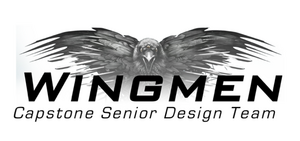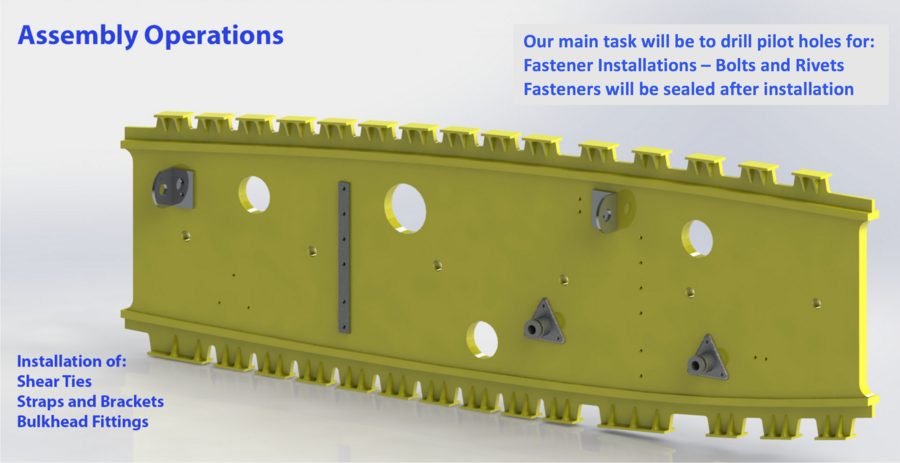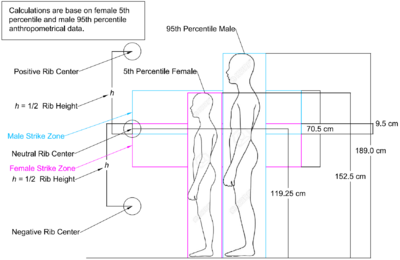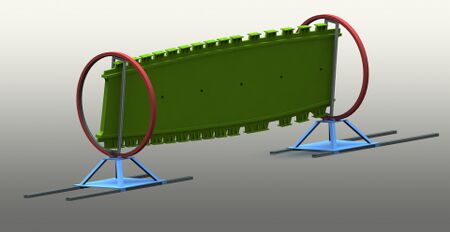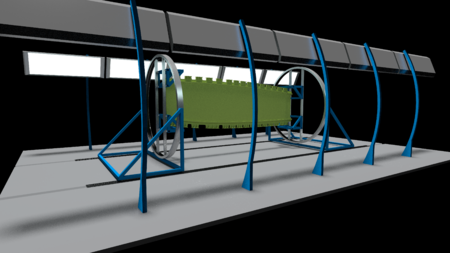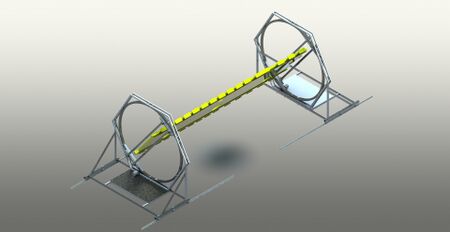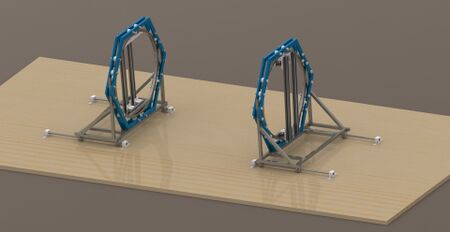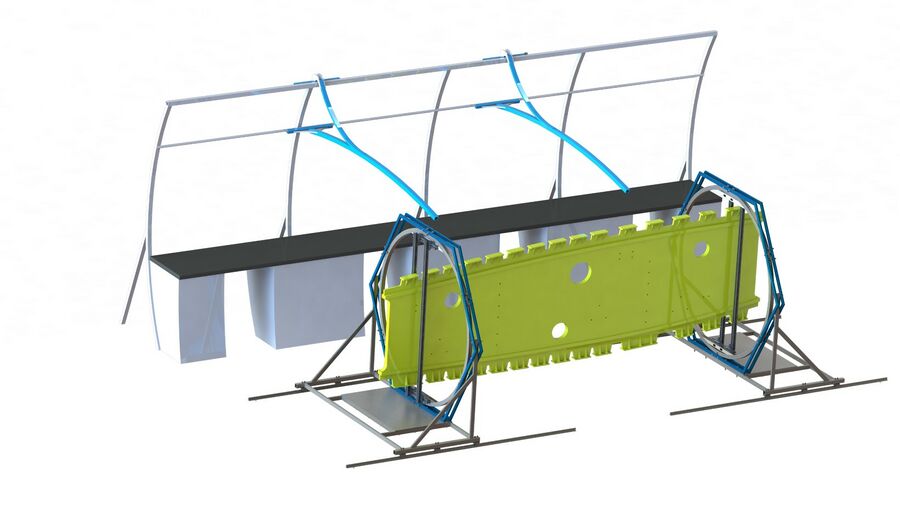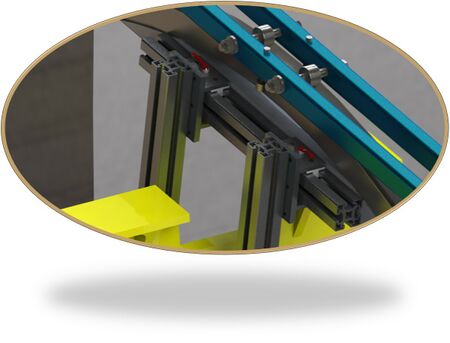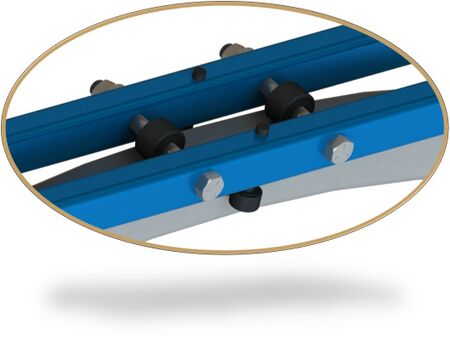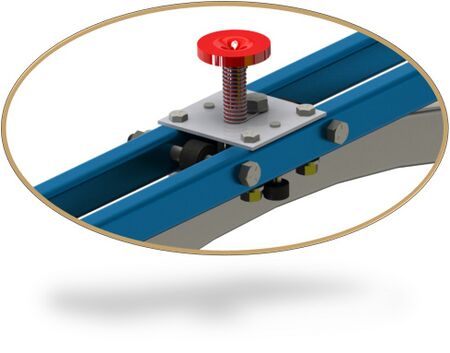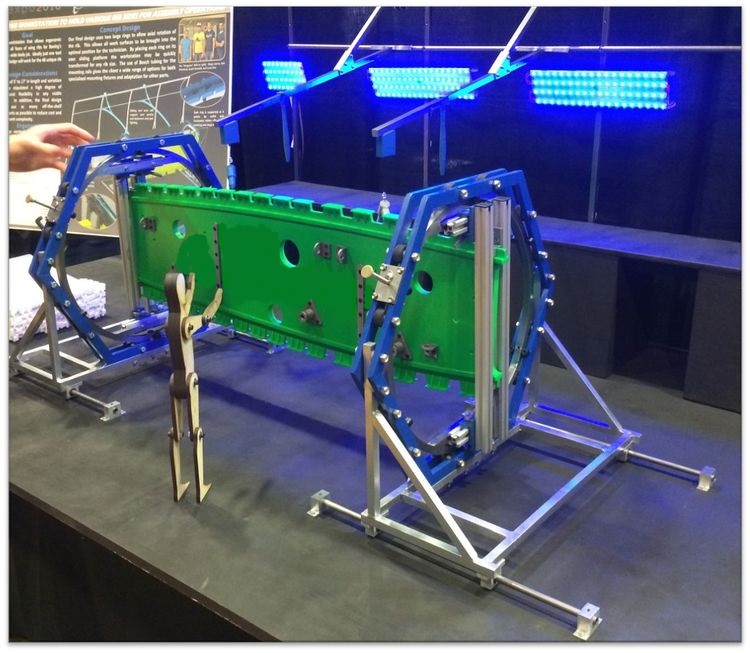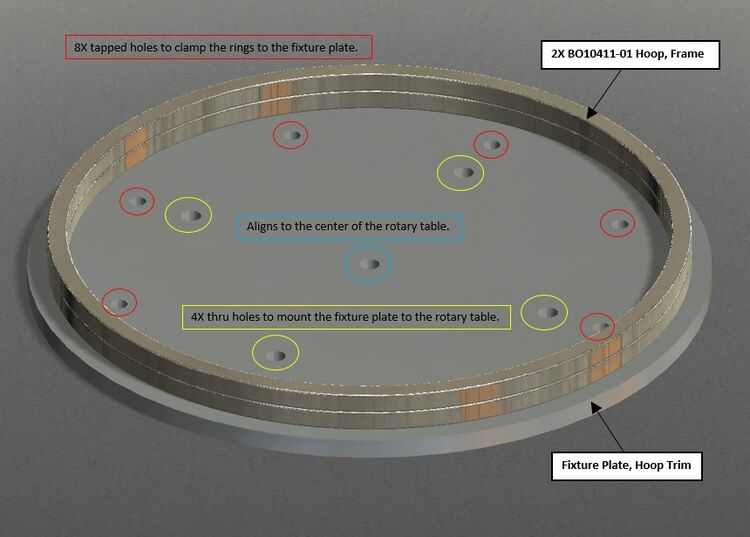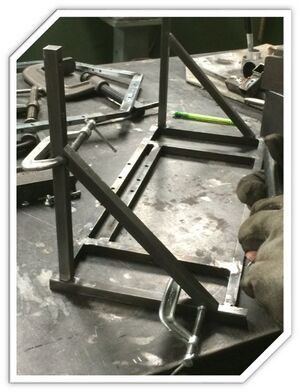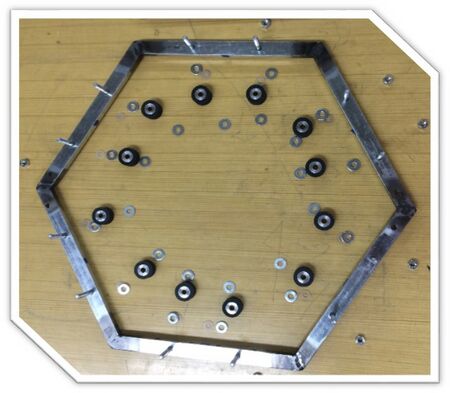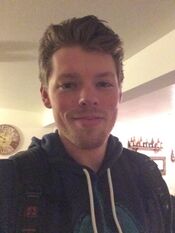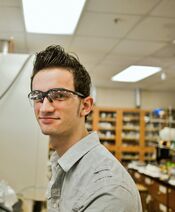Boeing Wing Rib Workstation
| Sponsors | Boeing |
| Team Name | The Wingmen |
| Duration | Fall 2015 - Spring 2016 |
| Faculty Advisors |
|
| Graduate Advisor | |
| Students |
|
The goal of this project is to develop a workstation that will facilitate all assembly of secondary components for a "generic" lower wing rib. Further considerations are laid out below and center around a movable workstation/tool system. The station will have modular options to eliminate redundant rib tools, and dynamic traits that will ease handling and assembly operations.
Problem Definition[edit | edit source]
Background[edit | edit source]
Boeing is currently in the process of constructing a new airplane, the 777X. With a new design come new challenges. One in particular is the manufacturing and handling of the parts. The ribs in particular cannot be handled in the same way they have been with regards to preparing them for installation. Boeing has given us the task of constructing a tool/workstation that will make the assembly of components on the rib easy and efficient.
Specifications[edit | edit source]
| Specifications | |||||
|---|---|---|---|---|---|
| General Requirements | Specific Requirements | Target Values | |||
| Modularity | Create a workstation that will adapt to accept all rib sizes. | 3 tools or less | |||
| Ease of Use | Create a complete workstation tool that includes the following: lighting, tool balancers, and air hose and power outlets | All tools with complete set of features | |||
| Ergonomics | Maintain the worker's ability to keep assembly operations within the "strike zone" | All assembly operations kept within strike zone | |||
| Adjustability | Efficient ability to make changes to a single tool to allow the incorporation of another sized rib | < 30 minutes to make changes to the tool before it’s ready for the next rib | |||
| Smooth Rotation | Efficiently rotate the rib | Free rotation with built in safety stops at desired rib orientations | |||
Deliverables[edit | edit source]
- Concept sketches/CAD models and developed ideas of suitable frames to house the different size ribs.
- Scale model prototype of a the complete workstation
- Suggestion of necessary workstation features and appropriate positioning of those feautures.
- Features include tool balancers and lighting
Assembly Operations to Perform[edit | edit source]
Ergonomics[edit | edit source]
Because the main purpose of this project is to facilitate easy handling and manipulation of large objects, ergonomics are a primary concern and focus. These considerations primarily center around the minor assembly that is to be performed on the wing component held by our tool. First and foremost we need to keep all assembly operations centered within the ergonomic strike or power zone. This region is identified by the vertical extent between the hip and top of the shoulder and approximately one to one and a half forearm lengths horizontally from the hip to shoulder line. The ideal vertical location is abeam to and one forearm length away from the elbow. This allows the technician or mechanic to support their tool or part with the least about of physical strain, using their body weight as the main force.
To quantify this area, anthropometric data tables were used to construct a diagram that shows how to calculate a universal strike zone for any rib size. The diagram uses the 95th percentile shoulder height for males and the 5th percentile elbow height for females to create the absolute bounds for our strike zone range. This means an ideal fit for 90 percent of possible user statures. The result of this analysis showed that the vertical movement that our machine must accommodate to fit this range would be close to the full vertical extent of the largest given rib. The overlap between male and female strike zones may ultimately be removed from this distance. Based on these findings we may have to reevaluate our strike zone goal since our calculations require almost 5 feet of vertical adjustability. Designs that use a variety of rib positioning to accommodate this full range may be a better alternative.
Repetitive injury from tool use is an issue that we will plan to address using a variety of tool counter balance or support devices. Finally safety considerations related to the placement of emergency stop buttons and protection of pinch or catch points related to any mechanical function of our eventual final design will need to be carefully considered.
Design Development[edit | edit source]
CAD Workstations[edit | edit source]
| Workstation Advantages and Disadvantages | |||||
|---|---|---|---|---|---|
| Workstation | Advantages | Disadvantages | |||
| Concept 1 |
-Bosch tubing box attached to inner ring enables a large number of potential ways to hold the rib -Linear rails allows the stations to open and close on the rib making vertical crane loading and unloading easy -Sprocket gear under the base to drive the chain attached to the inner ring, providing rotation of the rib. |
-Subsystem to fix the rib in the hoops are not fully developed -High base frame to hold the hoop creates a large potential moment -High expense to manufacture the hoop -Sectioning of the hoop will be required, increasing assembly time | |||
| Concept 2 |
-Stable base frame -Incorporation of lighting -Hoop design provides rotation of the rib -2 Hoops stations with linear motion along the rails allows easy rib loading and unloading -Tentative holding fixtures provides a sense of how the rib will be fixed to the hoops -Cam follower rollers between the inner ring and outer hoop provide smooth rotation |
-Subsystem to fix the rib in the hoops are not fully developed -No driving mechanism to move the inner ring inside the outer hoop -High expense to manufacture the hoop -Sectioning of the hoop will be required, increasing assembly time | |||
| Final Design |
-Allows for the whole rib to be within the strike zone through rotation. -Can accommodate multiple rib sizes through its track aligned movement. -Material is durable and within reasonable cost. |
- No conclusive way of rotating the hoop yet.
| |||
| Prototype Design |
-Safety factor is extremely high and cost is reasonable. -Rail system is very simple but highly effective. -Can easily be disassembled if the need to switch out parts arose. |
- Cannot accommodate larger sized ribs. | |||
Final Design[edit | edit source]
The final design (shown above) accommodates all the rib sizes and will help workers to safely and effectively accomplish all the required assembly operations on the ribs. More importantly it also accommodates the workers by taking in to consideration all the ergonomic factors. One key component that has been left out, is a way of holding the actual ribs. This was done so because at the time Boeing had not figured out which rib areas could be utilized. To compensate for that, our rib holding frame will be made from Bosch tubing. This will allow for compatibility with whatever holding design/mechanism they decide to use. Overall the final workstation has a few key components that allow our design to comply with the specifications set by Boeing and the group. These key components are definitely worth mentioning.
Bosch Tubing Frame[edit | edit source]
The Bosch tubing frame is key to attaching and holding the ribs. By having the vertical bosch frames attached to sliders (which then attach to a horizontal bosch piece), they can be moved out, at which point the rib can be brought through, and then moved back in to hug the rib. The locking mechanisms (red handles) can then be locked into place preventing the rib and bosch tubing from moving. This design allows for a quick and easy process of loading and unloading ribs.
Hoop/Rollers[edit | edit source]
Rotation is key to our design. It is of the utmost importance that we be able to rotate the hoop component and in turn the rib. The rotation is what allows us to be able to meet all the ergonomic requirements, thereby making it easier and faster to complete all the assembly operations necessary, on the rib. To achieve this, the outer edge of the hoop component comes into contact with 12 rollers (placed all around the hex-frame) allowing it to rotate smoothly as well as offsetting the weight and balance making the hoop component concentric. To prevent the hoop component from sliding out of place to either side, 12 vertical cam followers are placed around the outside of the hex-frames and come into contact with the side faces of the hoop. This system together enables for the hoop to rotate smoothly while staying vertical and concentric inside the hex-frames.
Locking Mechanism[edit | edit source]
With regard to ergonomics, we need to be able to lock the hoop at certain angles that allow for the worker to be in the strike zone of the rib area they intend to work on. We determined six necessary rotational positions that would allow the assembler to work comfortably on the rib faces. To achieve this, we intend to drill radial holes at the intended angle locations on the hoop. We then developed the locking mechanism. Basically the pin is compressed against the outside diameter of the hoop, and when the hoop is rotated the pin will push itself into the holes. This effectively locks the hoop in that rotational position. The worker can then safely work on the rib without having to worry about movement. Overall the stop mechanism provides two functions, an ability to meet all the strike zone requirements and acting as a rotational safety lock.
Final Prototype[edit | edit source]
Hoop Design[edit | edit source]
The hoop is the most critical part of our design. It sustains the frame which will hold the ribs in place. It is the component that allows for rotation, thereby meeting the ergonomic and manufacturing standards necessary to work on the ribs in an effective manner. In a sense we have built the frame and all other components from the hoop out. While Boeing will have the capabilities to create such a product in a solid state, we have had to rely on a company that has bent metal bars into the proper shape. However, these bars are off somewhat and must also be welded at the ends. If the hoops are not identical and concentric to one and other, then our design will not function as intended. To fix this we will be using a fixture plate to trim and align them on a rotary table (as can be seen). This will then enable us to satisfy the design requirements.
Manufacturing Process[edit | edit source]
With regards to manufacturing the prototype, there was quite a bit of work done. We milled and machined a lot of the parts using the mill and lathe. Some of the parts such as the hex frame, required us to make jigs/fixtures that would allow us to machine them. The support frame, hex frame, and hoop required welding. We also 3D printed quite a few parts such as the bosch tubing sliders. All in all, there was a ton of machining, welding, and 3D printed which then led to the assembly process at which time we had to make adjustments and then painted the parts. In the end everything came together perfectly.
